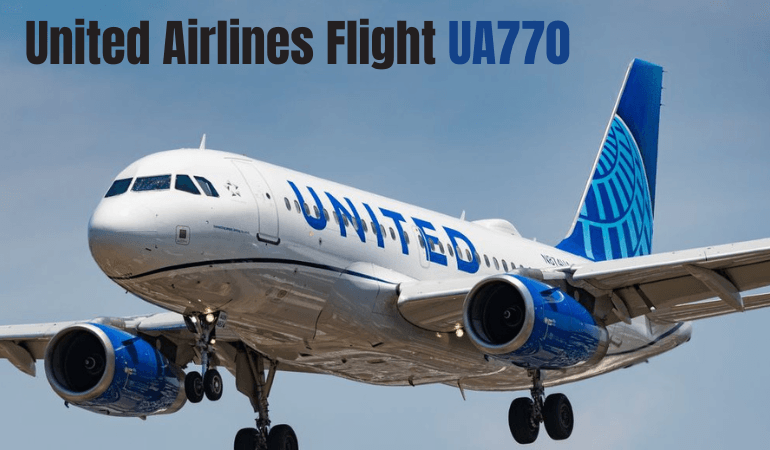United Airlines Flight UA770 Emergency Diversion: Full Story Explained

Introduction: When Routine Flight Turned Into a Global Headline
The United Airlines Flight UA770 Emergency Diversion occurred during a scheduled route that began smoothly under clear skies. Passengers expected an uneventful trip, unaware that they would soon witness the airline’s emergency response procedures in real time. As the aircraft approached cruising altitude, the pilots detected irregularities in the cabin pressure system, prompting an immediate decision to follow established safety protocols.United Airlines Flight UA770 Emergency Diversion
This decision transformed a standard cross-country flight into an international news story. The crew maintained professionalism, communicating clearly with air traffic control and ensuring passengers remained calm. Within minutes, the flight’s diversion became a headline across major aviation outlets, highlighting how swiftly and safely modern airlines can respond to critical technical challenges.
Flight Overview: Route, Aircraft, and Crew Details
United Airlines Flight UA770 was operated by a Boeing aircraft known for its reliability and efficiency. The route, originally planned from San Francisco to Boston, represented one of United’s key domestic connections. With over 250 passengers onboard, including seasoned travelers and families, the crew’s responsibility was immense from the moment the flight departed the gate.
The pilots and flight attendants aboard UA770 were highly trained in handling emergencies. Their quick thinking during the incident showcased the effectiveness of United’s ongoing safety training programs. Even as the flight experienced technical issues, the passengers were reassured through calm, clear announcements, proving how vital communication is in aviation safety.
The Moment of Crisis: How the Emergency Unfolded

The crisis began when the cockpit instruments signaled a potential malfunction in the cabin pressure system. Within moments, the pilots followed FAA-approved emergency protocols to ensure passenger safety. They coordinated with air traffic controllers and requested priority handling for an immediate diversion to the nearest suitable airport.
Inside the cabin, passengers reported feeling the aircraft descend more rapidly than expected, though the crew maintained order and professionalism. The United Airlines Flight UA770 Emergency Diversion was executed with precision, ensuring that the passengers experienced minimal discomfort during the unexpected turn of events.
The Emergency Diversion: Decision, Landing, and Response
Once the diversion was declared, United Airlines Flight UA770 changed course toward London Heathrow Airport. The pilots’ decision to land at one of the world’s most equipped airports proved wise. Emergency response teams were alerted in advance, preparing for a potential worst-case scenario. Fortunately, the landing was smooth, and all passengers were safe.
Upon landing, maintenance teams quickly inspected the aircraft to determine the cause of the issue. United Airlines issued a statement praising the flight crew for their professionalism and confirming that all safety protocols were followed precisely. The United Airlines Flight UA770 Emergency Diversion became an example of how quick, coordinated actions can ensure the best possible outcome in aviation emergencies.
Investigating the Cause: What Triggered the Diversion
Initial reports indicated that a problem in the cabin pressure system was the root cause of the emergency. Although not a catastrophic failure, such malfunctions require immediate attention to prevent escalation. Aviation authorities, including the FAA, collaborated with United Airlines’ technical teams to investigate the exact sequence of events.
This incident underscored the importance of rigorous aircraft maintenance and continuous monitoring of flight systems. The United Airlines Flight UA770 Emergency Diversion served as a reminder that even with advanced technology, human expertise and preparedness remain essential components of flight safety.
Crew and Passenger Safety: How Training Saved Lives
Every member of the United Airlines Flight UA770 crew played a crucial role in ensuring passenger safety. Their calm demeanor during the emergency reflected extensive simulator training and adherence to standard operating procedures. Such professionalism transforms potential crises into manageable situations, reinforcing passenger trust in the airline industry.
Passengers later described feeling anxious at first but quickly reassured by the cabin crew’s confidence. This response validated the airline’s investment in training programs that emphasize communication, teamwork, and crisis management. The UA770 incident demonstrated that aviation safety is not only about machines but also about the people who operate them.
Media Coverage and Public Reactions
Global media outlets rapidly picked up the story. From FlightAware updates to live reports on aviation blogs, the United Airlines Flight UA770 Emergency Diversion became headline news. The public response was overwhelmingly positive, with many praising the pilots and crew for handling the incident flawlessly. On social media, passengers shared firsthand accounts that reinforced the professionalism displayed during the event.
The story also sparked discussions about the safety of modern air travel. Experts pointed out that diversions like UA770’s are rare but necessary precautions that demonstrate aviation’s commitment to safety rather than its failure.
Lessons for Aviation Safety: What the UA770 Case Teaches
The United Airlines Flight UA770 Emergency Diversion provided valuable insights for the aviation industry. It reaffirmed that immediate, informed decision-making by flight crews can prevent serious outcomes. Airlines continuously refine their safety protocols based on such real-world experiences, ensuring that each lesson contributes to safer skies for everyone.
This event also highlighted the collaboration between pilots, air traffic control, and emergency responders. Their teamwork proved that global aviation safety depends on coordinated effort, not just advanced equipment. UA770’s story stands as a testament to the resilience and professionalism of those who keep air travel safe.
Conclusion: A Story of Professionalism, Safety, and Calm Under Pressure
The United Airlines Flight UA770 Emergency Diversion was not a tale of disaster, but one of skill, discipline, and teamwork. From the first warning light to the safe landing, every action taken by the crew reflected the airline’s strong safety culture. No passengers were harmed, and the situation was handled exactly as training intended.
In the end, this event reaffirmed public confidence in the aviation industry’s ability to manage emergencies effectively. The story of UA770 reminds us that even in moments of uncertainty, preparation, professionalism, and quick decision-making can make all the difference.
FAQs About United Airlines Flight UA770 Emergency Diversion
What caused the United Airlines Flight UA770 Emergency Diversion?
A technical issue in the cabin pressure system prompted the diversion for safety reasons.
Were there any injuries during the incident?
No, all passengers and crew landed safely without injury.
Where did United Airlines Flight UA770 land after diverting?
The flight diverted safely to London Heathrow Airport for inspection and assistance.
How did the crew manage the emergency?
Through calm communication, teamwork, and strict adherence to FAA-approved procedures.
What did United Airlines say after the diversion?
The airline praised the professionalism of its pilots and confirmed all safety measures were correctly executed.



